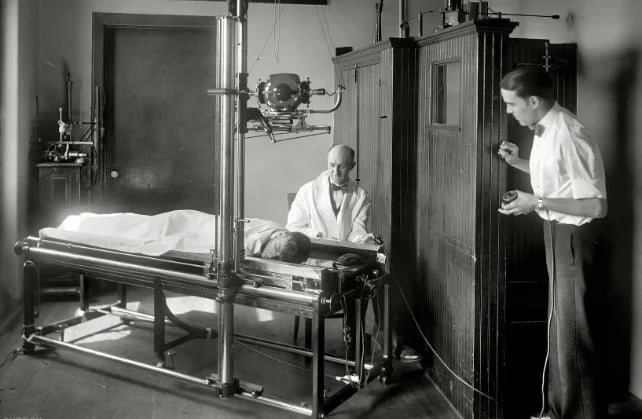How X-rays Revolutionized Healthcare
X-rays have undoubtedly transformed the landscape of modern healthcare. Since their discovery in 1895 by Wilhelm Conrad Roentgen, this technology has dramatically improved our ability to diagnose and treat a variety of medical conditions. From helping doctors identify broken bones to providing early detection of life-threatening diseases, X-rays have played a crucial role in shaping the medical field. In this blog post, we’ll explore the ways in which X-rays revolutionized healthcare and continue to play a pivotal role in saving lives.
2/25/20254 min read


1. A Game-Changer in Diagnostics
Diagnosing internal injuries and illnesses was far more difficult before the discovery of X-rays. Doctors had to depend on physical exams, patient history, and in some cases, exploratory surgery to understand what was happening within the body. With the invention of X-rays, doctors could see bones, organs, and tissues without the necessity for invasive surgery.
With the help of X-ray technology, medical practitioners are able to identify fractures, tumors, infections, and other diseases at their initial stages. X-ray imaging also gives the option to track the healing process of injuries, monitor the development of disease, and assist in surgical procedures.
2. Non-invasive and Painless Imaging
One of the most revolutionary features of X-rays is the fact that they allow detailed images inside the body without discomfort to the patient. Before X-ray machines, physicians were forced to rely on physical exams, which at times were painful or unable to diagnose deeper problems. The fact that X-rays are non-invasive has revolutionized the diagnostic process for everything from broken bones to serious medical conditions.
X-ray imaging takes the form of sending a low dose of radiation through the body and recording images of the ways in which the radiation interacts with various tissues. It is rapid, taking mere minutes, and is not particularly uncomfortable for patients.
3. Early Detection of Diseases
One of the most significant advantages of X-ray technology is the capability to detect diseases in their initial stages. Early detection can be a key factor in the treatment of most life-threatening diseases, including cancer, heart disease, and lung infections. For instance, mammograms utilize X-ray technology to identify early symptoms of breast cancer before a patient can feel a lump or mass. Chest X-rays are also frequently used to identify lung cancer, pneumonia, and tuberculosis.
X-ray technology is also used to identify diseases such as osteoporosis, where bone loss is identified before fractures happen, or to identify dental problems such as cavities and infections.
4. Guiding Medical Treatments and Procedures
X-rays have become a fundamental tool not just in diagnosis but also in the direction of medical procedures and treatments. For instance, physicians utilize fluoroscopy, a form of X-ray imaging that gives real-time moving images, to assist them during procedures like stent placement, biopsies, or finding foreign bodies in the body. This real-time feedback greatly enhances the precision and success rate of these interventions.
Also, X-rays aid in the planning and performance of some surgeries. X-ray guidance is often used by surgeons to make sure that they are in the right location, minimizing the chances of complications and optimizing patients' outcomes.
5. Revolutionizing Emergency Care
In emergency rooms, time is crucial. X-ray technology has been priceless in rapidly diagnosing afflictions like bone fractures, internal bleeding, and collapsed lungs. Whether the victim is from a car accident or someone who has suddenly developed chest pains, X-rays assist in allowing the doctors to quickly judge the situation and respond immediately.
X-rays have also been crucial in the treatment of trauma, allowing medical professionals to see injuries that may not be visible at first. Such quick and precise diagnosis can be the difference between life and death in dire circumstances.
6. Advances in X-ray Technology
Ever since the early years of X-ray imaging, technology has improved these diagnostic devices to be even more accurate and effective. Digital X-rays, for example, provide better resolution images with reduced radiation exposure, and computer-aided detection (CAD) systems can help radiologists detect abnormalities in images, resulting in earlier disease detection. Additionally, technologies like 3D imaging and dual-energy X-ray absorptiometry (DEXA) have increased the scope of applications of X-rays in medical diagnostics as well as treatment.
7. Wider Applications in Medicine
Apart from conventional applications in the diagnosis of bone fractures or lung conditions, X-ray technology has also found broader applications in various aspects of healthcare. In dental practice, for instance, X-rays are a basic instrument for the detection of cavities, gum infection, and abscesses. In orthopedics, X-rays aid in preoperative planning and follow-up. Moreover, X-ray machines find extensive application in the chest, abdominal, and pelvic examination for detecting abnormalities of internal organs like the heart, liver, and kidneys.
X-rays are also used to monitor those patients receiving long-term therapies, like cancer patients who receive ongoing scans to follow tumor regression or remission. In other areas, like veterinary medicine, X-rays are used to diagnose illnesses in pets and animals to provide improved care for our furry friends.
8. The Future of X-ray Technology in Healthcare
As medical science grows, so does the use of X-rays in medicine. Future technologies like artificial intelligence (AI) and machine learning will make X-ray imaging even more valuable in diagnosis. AI can already review X-ray pictures with incredible efficiency and precision, possibly catching problems that a human radiologist would overlook.
Also, innovations in radiation safety and contrast media are assisting in reducing risks in X-ray imaging, with the patient receiving the most precise and least invasive therapy possible.




Reference Website Link:
National Institute of Biomedical Imaging and Bioengineering (NIBIB)
American College of Radiology (ACR)
Radiological Society of North America (RSNA)
Mayo Clinic: X-ray Imaging
https://www.mayoclinic.org/tests-procedures/x-ray/about/pac-20384914
